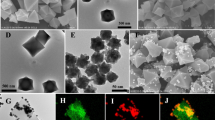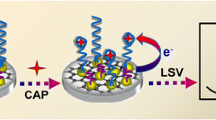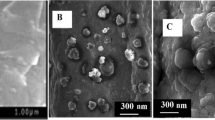Abstract
Using gold (Au) nanoparticle decorated Ti3C2Tx (Ti3C2Tx-Au) nanocomposites, a highly sensitive electrochemical aptasensor for the effective detection of chloramphenicol has been developed. As a two-dimensional layered material, the prepared composite not only provides high surface area, good conductivity, and thermal stability but also substantial binding sites for aptamers with high sensitivity and selectivity for the accurate determination of chloramphenicol. Interestingly, the conductivity and active sites were enhanced by freeze-drying Ti3C2Tx and in situ formation of Ti3C2Tx-Au nanocomposite. The fabricated aptasensor exhibited a very low detection limit (S/N ≥ 3) of 13.18 fg mL−1 with a linear range of 1 ~ 700 pg mL−1 and correlation coefficient of 0.9992. The fabricated aptasensor demonstrated an excellent reproducibility, repeatability, long-term stability, and high selectivity toward chloramphenicol. Further, the aptasensor was applied to real milk samples, and the recoveries were ranged from 98.93 to 101.93%.
Graphical abstract










Similar content being viewed by others
References
Jardetzky O (1963) Studies on the mechanism of action of chloramphenicol. I. The conformation of chlioramphenicol in solution. J Biol Chem 238:2498–508
Livingston RJ, Butterworth JW, Belt P (2013) Reaction or infection: topical chloramphenicol treatment. Ann R Coll Surg Engl 95(1):e20–e21
Holden WM, Ebert AR, Canning PF, Rollins-Smith LA (2014) Evaluation of amphotericin B and chloramphenicol as alternative drugs for treatment of chytridiomycosis and their impacts on innate skin defenses. Appl Environ Microbiol 80(13):4034–4041
Hanekamp JC, Bast A (2015) Antibiotics exposure and health risks: chloramphenicol. Environ Toxicol Pharmacol 39(1):213–220
Commission decision 2004/25/EC (2004) As regards the setting of minimum required performance limits (MRPLs) for certain residues in food of animal origin. Off J Eur Union 6:38–39
Miyamura S, Oketani S (1962) Studies on chloramphenicol inactivation by microorganisms. 2. Relation between chloramphenicol inactivation and chloramphenicol resistance in various microorganisms. Nihon saikingaku zasshi Jpn J Bacteriol 17:294–6
Chang X, Wu Q, Wu Y, Xi X, Cao J, Chu H, Liu Q, Li Y, Wu W, Fang X, Chen F (2022) Multifunctional Au modified Ti3C2-MXene for photothermal/enzyme dynamic/immune synergistic therapy. Nano Lett 22(20):8321–8330
Zhang H, Wang Z, Wang F, Zhang Y, Wang H, Liu Y (2020) In situ formation of gold nanoparticles decorated Ti3C2 MXenes nanoprobe for highly sensitive electrogenerated chemiluminescence detection of exosomes and their surface proteins. Anal Chem 92(7):5546–5553
Qu W, Zhao H, Zhang Q, Xia D, Tang Z, Chen Q, He C, Shu D (2021) Multifunctional Au/Ti3C2 photothermal membrane with antibacterial ability for stable and efficient solar water purification under the full spectrum. ACS Sustain Chem Eng 9(34):11372–11387
de Faria LV, Lisboa TP, da Silva Campos N, Alves GF, Matos MAC, Matos RC, Munoz RAA (2021) Electrochemical methods for the determination of antibiotic residues in milk: a critical review. Analytica Chimica Acta 1173:338569
Young KK, Choi CC, Oh JY, Kim H, Kweon GR, Lee JC (2005) Chloramphenicol arrests transition of cell cycle and induces apoptotic cell death in myelogenous leukemia cells. J Microbiol Biotechnol 15(5):913–918
Yang Y, Ren G, Yang W, Qin X, Gu D, Liang Z, Guo D-Y, Qinhe P (2021) A new MOF-based fluorescent sensor for the detection of nitrofuran antibiotics. Polyhedron 194:114923
Sun Y, Zhao J, Liang L (2021) Recent development of antibiotic detection in food and environment: the combination of sensors and nanomaterials. Microchimica Acta 188:1–22
Cong Z, Song Z, Ma Y, Zhu M, Zhang Y, Wu S, Gao E (2021) Highly emissive metal-organic frameworks for sensitive and selective detection of nitrofuran and quinolone antibiotics. Chem-an Asian J 16(13):1773–1779
Kim B, Lim D, Jin HJ, Lee HY, Namgung S, Ko Y, Park SB, Hong S (2012) Family-selective detection of antibiotics using antibody-functionalized carbon nanotube sensors. Sensors Actuators B-Chem 166:193–199
Liu J, Li Y, Liu L, Gao Y, Zhang Y, Yin Z, Pi F, Sun X (2020) Current progress on antibiotic sensing based on ratiometric fluorescent sensors. Bull Environ Contam Toxicol 107:176–184
Tajik H, Malekinejad H, Razavi-Rouhani SM, Pajouhi MR, Mahmoudi R, Haghnazari A (2010) Chloramphenicol residues in chicken liver, kidney and muscle: a comparison among the antibacterial residues monitoring methods of four plate test, ELISA and HPLC. Food Chem Toxicol: Int J Published Br Ind Biol Res Assoc 48(8–9):2464–2468
Moudgil P, Bedi JS, Aulakh RS, Gill JPS, Kumar A (2019) Validation of HPLC multi-residue method for determination of fluoroquinolones, tetracycline, sulphonamides and chloramphenicol residues in bovine milk. Food Anal Methods 12(2):338–346
Kawano S-I, Hao H-Y, Hashi Y, Lin J-M (2015) Analysis of chloramphenicol in honey by on-line pretreatment liquid chromatography-tandem mass spectrometry. Chin Chem Lett 26(1):36–38
Wang H, Zhou X-J, Liu Y-Q, Yang H-M, Guo Q-L (2011) Simultaneous determination of chloramphenicol and aflatoxin M-1 residues in milk by triple quadrupole liquid chromatography-tandem mass spectrometry. J Agric Food Chem 59(8):3532–3538
Wang L, Zhang Y, Gao X, Duan Z, Wang S (2010) Determination of chloramphenicol residues in milk by enzyme-linked immunosorbent assay: improvement by biotin-streptavidin-amplified system. J Agric Food Chem 58(6):3265–3270
Zahra QUA, Luo Z, Ali R, Khan MI, Li F, Qiu B (2021) Advances in gold nanoparticles-based colorimetric aptasensors for the detection of antibiotics: an overview of the past decade. Nanomaterials 11(4):840
Khan MZH (2022) Recent Biosensors for detection of antibiotics in animal derived food. Crit Rev Anal Chem 52(4):780–790
Mehlhorn A, Rahimi P, Joseph Y (2018) Aptamer-based biosensors for antibiotic detection: a review. Biosensors 8(2):54
Naguib M, Kurtoglu M, Presser V, Lu J, Niu J, Heon M, Hultman L, Gogotsi Y, Barsoum MW (2011) Two-dimensional nanocrystals produced by exfoliation of Ti3AlC2. Adv Mater 23(37):4248–4253
Naguib M, Come J, Dyatkin B, Presser V, Taberna P-L, Simon P, Barsoum MW, Gogotsi Y (2012) MXene: a promising transition metal carbide anode for lithium-ion batteries. Electrochem Commun 16(1):61–64
Naguib M, Mochalin VN, Barsoum MW, Gogotsi Y (2014) 25th Anniversary Article: MXenes: a new family of two-dimensional materials. Adv Mater 26(7):992–1005
Chen C, Boota M, Urbankowski P, Anasori B, Miao L, Jiang J, Gogotsi Y (2018) Effect of glycine functionalization of 2D titanium carbide (MXene) on charge storage. J Mater Chem A 6(11):4617–4622
Kurra N, Ahmed B, Gogotsi Y, Alshareef HN (2016) MXene-on-paper coplanar microsupercapacitors. Adv Energy Mater 6(24):1601372
Zou G, Zhang Z, Guo J, Liu B, Zhang Q, Fernandez C, Peng Q (2016) Synthesis of MXene/Ag composites for extraordinary long cycle lifetime lithium storage at high rates. ACS Appl Mater Interfaces 8(34):22280–22286
Er D, Li J, Naguib M, Gogotsi Y, Shenoy VB (2014) Ti3C2 MXene as a high capacity electrode material for metal (Li, Na, K, Ca) ion batteries. ACS Appl Mater Interfaces 6(14):11173–11179
Lorencova L, Gajdosova V, Hroncekova S, Bertok T, Blahutova J, Vikartovska A, Parrakova L, Gemeiner P, Kasak P, Tkac J (2019) 2D MXenes as perspective immobilization platforms for design of electrochemical nanobiosensors. Electroanalysis 31(10):1833–1844
Rakhi RB, Nayuk P, Xia C, Alshareef HN (2016) Novel amperometric glucose biosensor based on MXene nanocomposite. Sci Rep 6:36422
Shuck CE, Han M, Maleski K, Hantanasirisakul K, Kim SJ, Choi J, Reil WEB, Gogotsi Y (2019) Effect of Ti3AlC2MAX phase on structure and properties of resultant Ti3C2TxMXene. ACS Appl Nano Mater 2(6):3368–3376
Huang X, Wu P (2020) A facile, high-yield, and freeze-and-thaw-assisted approach to fabricate MXene with plentiful wrinkles and its application in on-chip micro-supercapacitors. Adv Funct Mater 30(12):1910048
Srivastava P, Mishra A, Mizuseki H, Lee K-R, Singh AK (2016) Mechanistic insight into the chemical exfoliation and functionalization of Ti3C2 MXene. ACS Appl Mater Interfaces 8(36):24256–24264
Wang H-W, Naguib M, Page K, Wesolowski DJ, Gogotsi Y (2015) Resolving the structure of Ti3C2Tx MXenes through multilevel structural modeling of the atomic pair distribution function. Chem Mater 28(1):349–359
Li M, Wang H, Wang X, Lu Q, Li H, Zhang Y, Yao S (2019) Ti3C2/Cu2O heterostructure based signal-off photoelectrochemical sensor for high sensitivity detection of glucose. Biosens Bioelectron 142:111535
Zhang S, Ma L, Ma K, Xu B, Liu L, Tian W (2018) Label-free aptamer-based biosensor for specific detection of chloramphenicol using AIE probe and graphene oxide. ACS Omega 3(10):12886–12892
Wang Z, Xianyu Y, Liu W, Li Y, Cai Z, Fu X, Jin G, Niu Y, Qi C, Chen Y (2019) Nanoparticles-enabled surface-enhanced imaging ellipsometry for amplified biosensing. Anal Chem 91(10):6769–6774
Wang S, He B, Liang Y, Jin H, Wei M, Ren W, Suo Z, Wang J (2021) Exonuclease III-driven dual-amplified electrochemical aptasensor based on PDDA-Gr/PtPd@Ni-Co hollow nanoboxes for chloramphenicol detection. ACS Appl Mater Interfaces 13(22):26362–26372
Chang CC, Wang G, Takarada T, Maeda M (2017) Iodine-mediated etching of triangular gold nanoplates for colorimetric sensing of copper ion and aptasensing of chloramphenicol. ACS Appl Mater Interfaces 9(39):34518–34525
Gu Q, Wang Z, Qiao L, Fan J, Pan Y, Wu P, Cai C (2021) Nitrogen-doped graphdiyne quantum dots for electrochemical chloramphenicol quantification in water. ACS Appl Nano Mater 4(11):12755–12765
Liu S, Lai G, Zhang H, Yu A (2017) Amperometric aptasensing of chloramphenicol at a glassy carbon electrode modified with a nanocomposite consisting of graphene and silver nanoparticles. Microchim Acta 184:1445–1451
Funding
This research was funded by the Shandong Provincial Natural Science Foundation (Grant No. ZR2019MB066) and the National Natural Science Foundation of China (Grants No. 21802052). The authors are thankful to the Deanship of Scientific Research and supervision of the Centre for Scientific and Engineering Research at Najran University, Najran, Kingdom of Saudi Arabia for funding under the Research Centers funding program Grant No. NU/RCP/SERC/12/6.
Author information
Authors and Affiliations
Corresponding authors
Ethics declarations
Consent for publication
All authors read the manuscript and agreed for submission.
Conflict of interest
The authors declare no competing interests.
Additional information
Publisher's note
Springer Nature remains neutral with regard to jurisdictional claims in published maps and institutional affiliations.
Rights and permissions
Springer Nature or its licensor (e.g. a society or other partner) holds exclusive rights to this article under a publishing agreement with the author(s) or other rightsholder(s); author self-archiving of the accepted manuscript version of this article is solely governed by the terms of such publishing agreement and applicable law.
About this article
Cite this article
Yang, X., Guo, W., Umar, A. et al. Electrochemical aptasensor based on gold nanoparticle decorated Ti3C2Tx nanocomposites for chloramphenicol detection. Microchim Acta 190, 206 (2023). https://doi.org/10.1007/s00604-023-05772-5
Received:
Accepted:
Published:
DOI: https://doi.org/10.1007/s00604-023-05772-5




